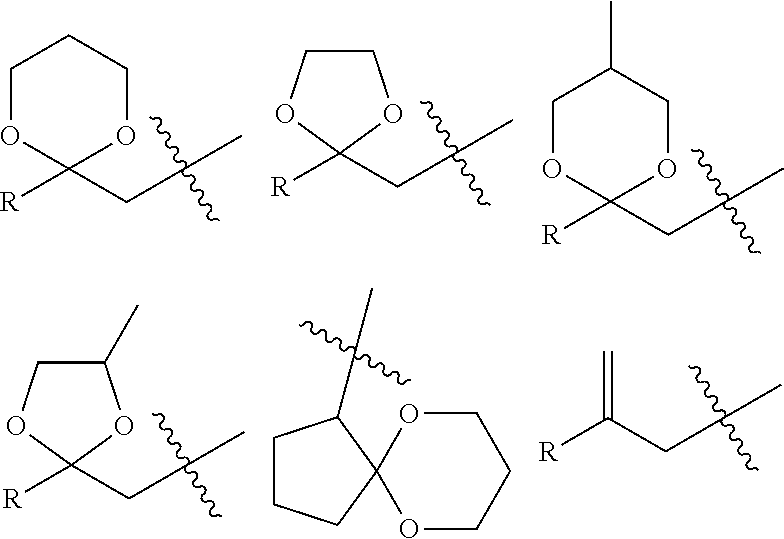Method of Stabilizing Fluorine-Containing Acid Amplifier
- Summary
- Abstract
- Description
- Claims
- Application Information
AI Technical Summary
Benefits of technology
Problems solved by technology
Method used
Image
Examples
reference example 1
[0097]A 200 ml round-bottom flask provided having a thermocouple and a dropping funnel was charged with 5 g (23 mmol) of 1,1,1-trifluoro-3-(2-methyl-1,3-dioxan-2-yl)propan-2-ol and 40 g of diisopropyl ether. To the flask, 24.5 ml of 1 mol / L lithium diisopropylamide was added dropwise over 30 minutes in a nitrogen atmosphere at −30° C. or lower (thereby obtaining a solution “A”). The solution was stirred for 30 minutes after the termination of the dropwise addition, followed by increasing the temperature of the solution to room temperature and then stirring it for additional 1 hour. Another 200 ml round-bottom flask provided having a thermocouple and a dropping funnel was charged with 6.5 g of 1,1-difluoro-2-oxo-(phenylamino)ethanesulfonyl fluoride and 30 g of diisopropyl ether and cooled to −30° C. in a nitrogen atmosphere. To this solution, the previously prepared solution “A” was added dropwise by using the dropping funnel to such an extent as not to exceed an inner temperature of...
reference example 2
[0099]A 200 ml round-bottom flask provided having a thermocouple and a dropping funnel was charged with 5 g (23 mmol) of 1,1,1-trifluoro-3-(2-methyl-1,3-dioxan-2-yl)propan-2-ol and 40 g of diisopropyl ether. To the flask, 24.5 ml of 1 mol / L lithium diisopropylamide was added dropwise over 30 minutes in a nitrogen atmosphere at −30° C. or lower (thereby obtaining a solution “B”). The solution was stirred for 30 minutes after the termination of the dropwise addition, followed by increasing the temperature of the solution to room temperature and then stirring it for additional 1 hour. Another 200 ml round-bottom flask provided having a thermocouple and a dropping funnel was charged with 7.4 g of 1,1-difluoro-2-oxo-(2-(((trifluoromethyl)sulfonyl)amino)ethyl 2-methylacryl)ethanesulfonyl fluoride and 30 g of diisopropyl ether and cooled to −30° C. in a nitrogen atmosphere. To this solution, the previously prepared solution “B” was added dropwise by using the dropping funnel to such an ext...
reference example 3
[0101]A 200 ml round-bottom flask provided having a thermocouple and a dropping funnel was charged with 5 g (23 mmol) of 1,1,1-trifluoro-3-(2-methyl-1,3-dioxan-2-yl)propan-2-ol and 40 g of diisopropyl ether. To the flask, 24.5 ml of 1 mol / L lithium diisopropylamide was added dropwise over 30 minutes in a nitrogen atmosphere at −30° C. or lower (thereby obtaining a solution “C”). The solution was stirred for 30 minutes after the termination of the dropwise addition, followed by increasing the temperature of the solution to room temperature and then stirring it for additional 1 hour. Another 200 ml round-bottom flask provided having a thermocouple and a dropping funnel was charged with 8.0 g of 2-(adamant-1-ylamino)-1,1-difluoro-2-oxoethanesulfonyl fluoride and 30 g of tetrahydrofuran and cooled to −30° C. in a nitrogen atmosphere. To this solution, the previously prepared solution “C” was added dropwise by using the dropping funnel to such an extent as not to exceed an inner temperat...
PUM
 Login to View More
Login to View More Abstract
Description
Claims
Application Information
 Login to View More
Login to View More - R&D
- Intellectual Property
- Life Sciences
- Materials
- Tech Scout
- Unparalleled Data Quality
- Higher Quality Content
- 60% Fewer Hallucinations
Browse by: Latest US Patents, China's latest patents, Technical Efficacy Thesaurus, Application Domain, Technology Topic, Popular Technical Reports.
© 2025 PatSnap. All rights reserved.Legal|Privacy policy|Modern Slavery Act Transparency Statement|Sitemap|About US| Contact US: help@patsnap.com



